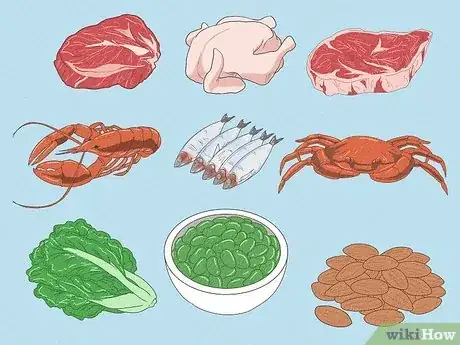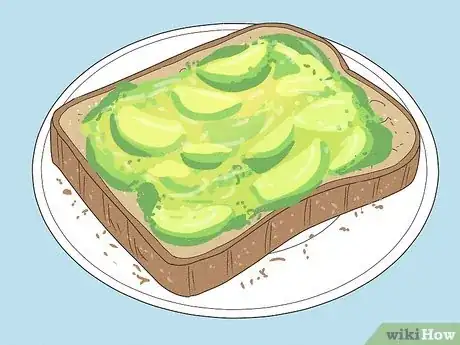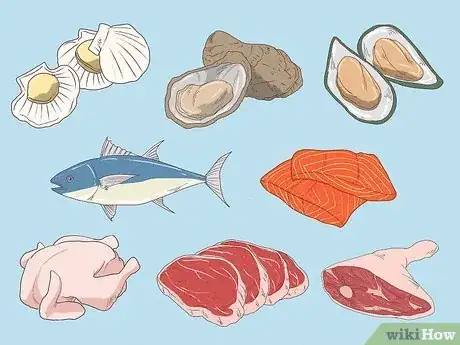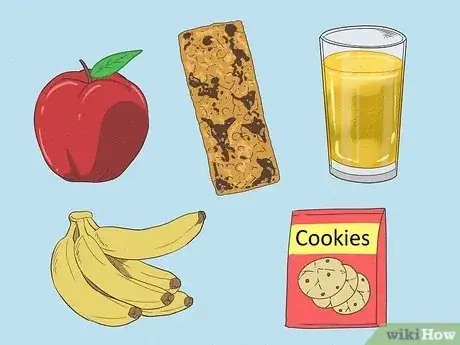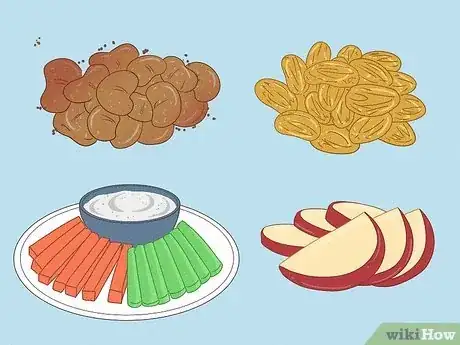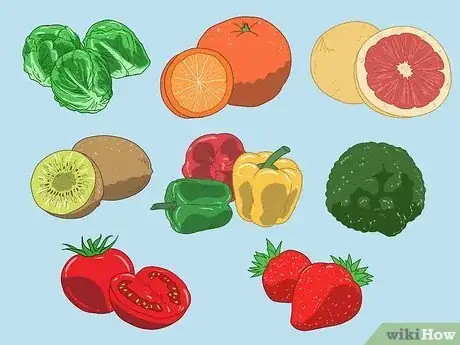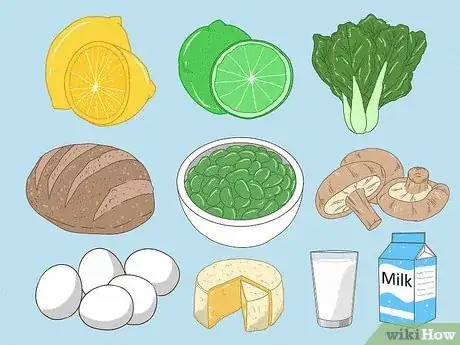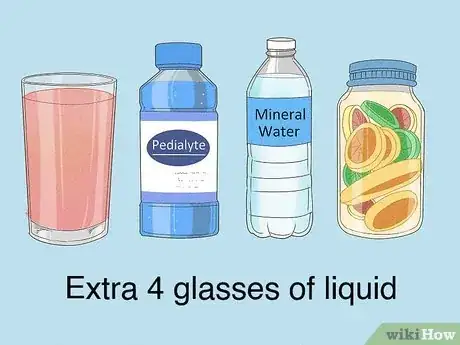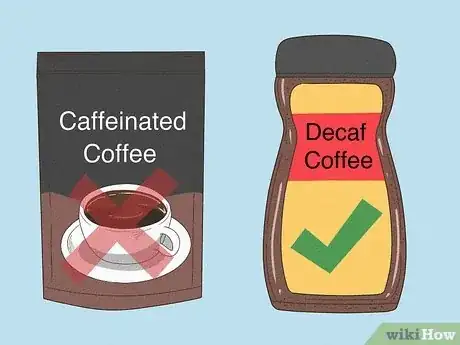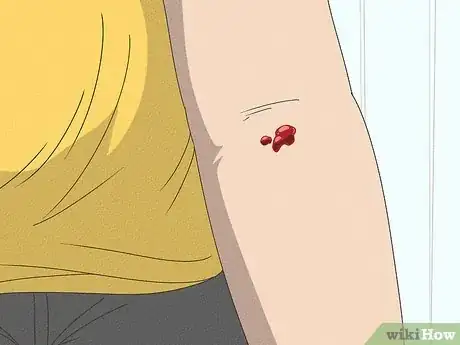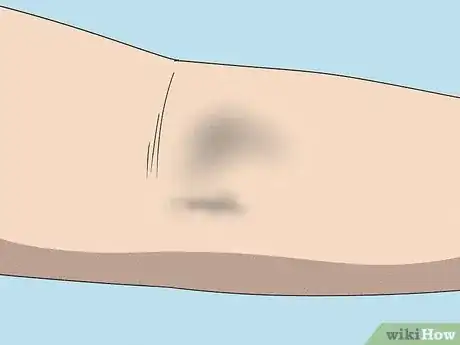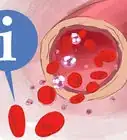This article was medically reviewed by Erik Kramer, DO, MPH and by wikiHow staff writer, Jessica Gibson. Dr. Erik Kramer is a Board-Certified Primary Care Physician at the University of Colorado. With over 15 years of experience, his clinical interests include obesity and weight management, diabetes care, and preventive care, as well as embracing a holistic approach to primary care. He received his Doctorate in Osteopathic Medicine (D.O.) from the Touro University Nevada College of Osteopathic Medicine and completed his residency at Central Maine Medical Center. Dr. Kramer is a Diplomate of the American Board of Obesity Medicine.
There are 22 references cited in this article, which can be found at the bottom of the page.
This article has been viewed 22,721 times.
When you're donating blood, you're probably focusing on the life-saving gift you're giving to people in your community. However, don't forget to take care of yourself. Donating blood is safe and easy, but your body needs a little TLC—there's a reason that blood centers set out cookies and treats for donors! In this article, we'll give you suggestions for nutritious food to eat and cover how to look after yourself following your blood donation, so you'll be back to feeling your absolute best.
Steps
Choosing Nutritious Food Before Giving Blood
-
1Prepare regular meals that are high in iron. Don't skip meals before you donate blood or your blood sugar levels could fluctuate, making you feel dizzy. Instead, stick to regular meals that have iron-rich ingredients. The center or drive will test your iron levels before you donate to see if they're high enough to give blood. To boost your iron levels, eat:[1] X Research source
- Beef & poultry
- Seafood
- Leafy greens
- Nuts and Beans
-
2Eat a snack right before you donate. Eating food increases your glucose levels, which can prevent you from feeling dizzy as you donate. Try to eat a snack before you head to the blood drive or donation center. Here are a few nutritious ideas:[2] X Trustworthy Source Red Cross Blood Donation Services Website run by the Red Cross Organization providing information about how and where to donate blood safely Go to source
- Cheese with fresh fruit
- Whole wheat bread with avocado
- Pita chips and hummus
Advertisement -
3Drink an extra 2 glasses of water before your donation. When you donate, you give 2 cups (470 ml) of blood, which is 50% water. By hydrating really well before you donate, you'll bounce back a lot faster! Just steer clear of caffeinated beverages because caffeine can block iron absorption. Instead, reach for:[3] X Research source
- Fruit juice
- Vegetable juice
- Seltzer water
- Non-caffeinated energy drinks
- Herbal tea
-
4Avoid drinking alcohol if you plan to donate blood. Alcohol can dehydrate you and affect your blood pressure. This may not seem like a big deal, but your body needs to be in the best shape for blood donation and recovery. Once you've donated, wait at least 24 hours before you enjoy an alcoholic drink.[4] X Research source
- You're safe to drink alcohol after the waiting-day period if you aren't feeling nauseated, dizzy, or lightheaded.
Eating Healthy After Donating
-
1Eat iron-rich meat, poultry, or seafood. The most common symptom after donating blood is fatigue because your iron levels take a hit. Iron is what carries oxygen throughout your body, so if your iron levels are low, you feel fatigued. To help you get energy back quickly, eat meat, protein, or seafood since these are high in iron and your body absorbs their iron easily. These are all great iron sources:[5] X Research source [6] X Trustworthy Source Red Cross Blood Donation Services Website run by the Red Cross Organization providing information about how and where to donate blood safely Go to source
- Oysters
- Clams
- Mussels
- Tuna
- Salmon
- Red meat
- Turkey
- Chicken liver
-
2Round out your meal with iron-rich produce. Fortunately, lots of produce contains iron, so if you're a vegetarian or vegan, you can still get the iron your body needs after donating blood. Here are some great plant-based sources of iron:[7] X Research source
- Beans like lima beans, navy beans, and kidney beans
- Nuts and legumes like almonds, cashews, walnuts, lentils, and tofu
- Vegetables like artichokes, asparagus, spinach, tomatoes, greens, and potatoes
- Fruits like dried apricots and prunes, raisins, dates, watermelon, cantaloupe, and bananas
-
3Grab a high-sugar snack immediately after donating. Most donation centers and blood drives have a snack area or canteen where they offer snacks and drinks. Sit down and eat something right away before you leave the center or blood drive. If you have dietary restrictions, bring a high-sugar snack with you before you donate so you'll have something to munch on during recovery. Centers usually offer snacks like:[8] X Trustworthy Source Cleveland Clinic Educational website from one of the world's leading hospitals Go to source
- Juice
- Cookies
- Granola bars
- Fresh fruit
-
4Reach for lean, unprocessed food instead of fried or fatty food. Whole foods tend to be lower in sodium, which causes dehydration, so fresh foods will help you rehydrate after giving blood. Remember, your body lost a lot of fluids and salty or rich foods can affect your hydration levels. If you can, skip fast food, fried meat, and salty snacks like chips and fries. Instead, healthy snacks like:[9] X Research source
- Dried fruit
- Roasted nuts
- Fresh veggies with dip
- Slices of fresh fruit
-
5Choose iron-fortified foods when you eat cereal or bread. It's hard to overemphasize how important iron-rich foods are following a blood donation! If you're eating cereal or bread, read the nutrition label and choose products that are iron-fortified—this means has been added to the food. If you eat iron-fortified cereal, you can get 100% of your daily value of iron in a single bowl![10] X Trustworthy Source Cleveland Clinic Educational website from one of the world's leading hospitals Go to source
- Whole-grain bread and sourdough bread are also excellent sources of iron.
-
6Add vitamin C-rich foods to your diet to help your body absorb iron. You can really boost your iron levels following blood donation by pairing iron-rich foods with foods high in vitamin C. This is especially important if you're vegetarian or vegan and not getting iron from a meat source. Foods high in vitamin C include:[11] X Research source
- Citrus like oranges, grapefruit, clementines, and orange juice
- Red and green peppers
- Tomatoes and tomato juice
- Kiwi
- Broccoli and brussels sprouts
- Strawberries
-
7Eat foods that have B vitamins like folic acid and riboflavin. B vitamins kickstart red blood cell production, which is critical to helping you overcome fatigue after donating blood. To get B vitamins, eat leafy green vegetables, citrus, whole grains, beans, and mushrooms. You can also get B vitamins from eggs, milk, and cheese.[12] X Trustworthy Source Johns Hopkins Medicine Official resource database of the world-leading Johns Hopkins Hospital Go to source
- Vitamin B2 is also called riboflavin, which helps convert carbohydrates into energy to spur on red blood cell production and reduce fatigue.[13] X Trustworthy Source MedlinePlus Collection of medical information sourced from the US National Library of Medicine Go to source
- Vitamin B9 is also called folic acid, which helps red blood cells form.
- To give your system a boost of folic acid, iron, and riboflavin, prepare a dish with chicken or beef liver with a side salad and whole grain bread for dinner the same day as you donated.[14] X Research source
-
8Drink an extra 4 glasses of liquid over the next day. Over half of the blood that you donated was water, so it's really important to rehydrate so you don't feel dizzy. Drink something before you leave the blood drive or donation center and try to drink an extra at least 4 8 fl oz (240 mL) glasses of water, fruit juice, or sports beverages over the next 24 hours.[15] X Research source
- Avoid drinking milk right after you donate, since calcium slows down your body's iron absorption.
- Carry around a bottle of water the rest of the day, so you remember to keep drinking fluids.
- It's fine to drink sports drinks that contain electrolytes, but avoid energy drinks, which are high in sugar and caffeine.
Feeling Your Best When Donating Blood
-
1Get extra rest and avoid strenuous exercise. You've just saved at least 1 person's life, so kick back—you've earned it! After you donate, avoid heavy labor or lifting for about 5 hours. This helps your body focus on replacing the blood you lost.[16] X Research source
- Pay attention to how you feel following your donation. If you start to feel dizzy, lightheaded, or weak, it's a sign you need to slow down and rest more.
-
2Limit your intake of caffeinated beverages. Caffeine can actually block iron absorption, so it takes longer to recover.[17] X Research source If your iron levels tend to be low in general, switch to decaffeinated coffee or tea and skip caffeinated sodas. If you're not concerned about your iron levels on a day-to-day basis, you're safe to enjoy a little caffeine later in the day.
- If you can't bear the thought of drinking decaf coffee, go for half-caffeinated so you're at least cutting back on your caffeine intake following the donation.
-
3Get a full night's sleep before and after your donation. Try to get between 7 to 9 hours of sleep, so you're completely rested before you give blood. Not only will you feel better while you donate, but a full night's sleep can also help you recover after giving blood.[18] X Research source
-
4Wear comfortable clothes with easy access to your elbow. Choose a loose-fitting outfit that's sleeveless, has short sleeves, or has sleeves you can easily roll above your elbow. This way, they'll be able to access your veins.[19] X Research source
- It can be a little chilly at some donation centers or blood drives, so consider bringing a light blanket if you get cold easily.
Common Side Effects of Giving Blood
-
1Fatigue: It's completely normal to feel a little more tired after you donate—after all, your body is now busy working to restore your blood levels. The best thing you can do is to rest and take it easy until you feel better. Don't forget to drink extra fluids, too![20] X Trustworthy Source US Department of Health and Human Services Federal department responsible for improving the health and well-being of Americans Go to source
-
2Bleeding at the site: If you notice that the spot on your elbow where the needle was begins to bleed after you remove the bandage, put pressure on it. Then, raise your arm into the air and hold it there for 5 to 10 minutes or until the bleeding stops.[21] X Research source
-
3Bruising at the site: You might see slight bruising near your inner elbow following your donation, especially during the first 24 hours. If so, apply a cold compress or wrapped ice pack for 15 minutes. You can repeat this every 2 hours.[22] X Trustworthy Source PubMed Central Journal archive from the U.S. National Institutes of Health Go to source
- The bruising will go away on its own within a few days.
-
4Dizziness or lightheadedness: If you suddenly feel lightheaded or dizzy, it usually means that you're working yourself too hard after your donation. Stop whatever it is you're doing and sit or lie down until you feel better.[23] X Research source
- If you continue to feel dizzy or lightheaded, contact the blood drive, donation center, or your doctor.
You Might Also Like


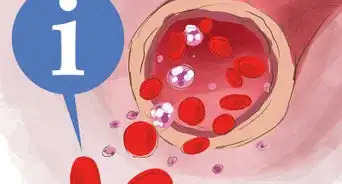
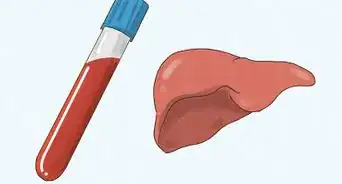



 Blood Blister Treatment Plus Causes and When to See a Doc
Blood Blister Treatment Plus Causes and When to See a Doc
-Step-14-Version-2.webp)
 Increasing Low Blood Sodium: At-Home and Medical Options
Increasing Low Blood Sodium: At-Home and Medical Options
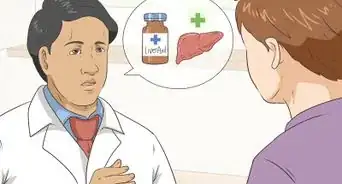


 How to Use a Wrist Blood Pressure Cuff
How to Use a Wrist Blood Pressure Cuff
References
- ↑ https://www.blood.co.uk/the-donation-process/preparing-to-give-blood/
- ↑ https://www.redcrossblood.org/donate-blood/blood-donation-process/before-during-after.html
- ↑ https://www.blood.co.uk/the-donation-process/preparing-to-give-blood/
- ↑ https://www.lifeblood.com.au/blood/making-your-donation/prepare-and-aftercare
- ↑ https://www.slma.cc/dos-and-donts-after-donating-blood/
- ↑ https://www.redcrossblood.org/donate-blood/blood-donation-process/before-during-after/iron-blood-donation/iron-rich-foods.html
- ↑ https://clinicalcenter.nih.gov/blooddonor/iron.html
- ↑ https://health.clevelandclinic.org/what-to-eat-before-and-after-donating-blood/
- ↑ https://www.redcross.org/content/dam/redcrossblood/landing-page-documents/246401_ironrichpyramid_flyer_ms_v02.pdf
- ↑ https://health.clevelandclinic.org/how-to-add-more-iron-to-your-diet/
- ↑ https://ods.od.nih.gov/factsheets/VitaminC-HealthProfessional/
- ↑ https://www.hopkinsmedicine.org/health/conditions-and-diseases/folate-deficiency-anemia
- ↑ https://medlineplus.gov/ency/article/002411.htm
- ↑ https://ods.od.nih.gov/factsheets/Folate-HealthProfessional/
- ↑ https://www.lifeblood.com.au/blood/making-your-donation/prepare-and-aftercare#donation-step-3
- ↑ https://www.scotblood.co.uk/news/top-tips-for-before-during-and-after-giving-blood/
- ↑ https://www.donateblood.org/wp-content/uploads/2018/09/iron-rich-foods.pdf
- ↑ https://myhealth.alberta.ca/Health/Pages/conditions.aspx?hwid=uf10217
- ↑ https://mndaksredcross.org/2019/06/13/six-things-to-know-before-blooddonation/
- ↑ https://www.hhs.gov/oidp/topics/blood-tissue-safety/donate-blood/index.html
- ↑ https://www.moh.gov.sa/en/HealthAwareness/EducationalContent/Diseases/Hematology/Pages/007.aspx
- ↑ https://www.ncbi.nlm.nih.gov/books/NBK310575/
- ↑ https://www.moh.gov.sa/en/HealthAwareness/EducationalContent/Diseases/Hematology/Pages/007.aspx
- ↑ https://www.cuimc.columbia.edu/news/surprising-benefits-donating-blood
About This Article

